
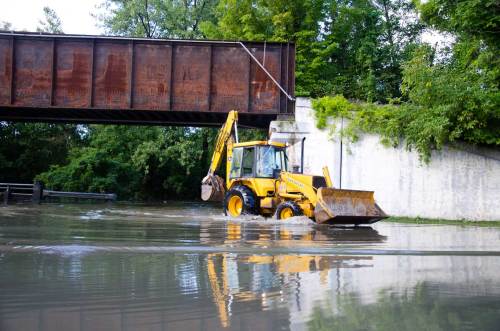
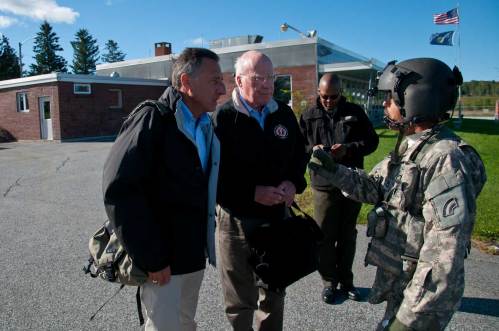




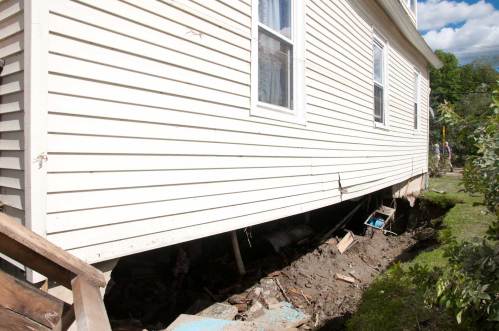

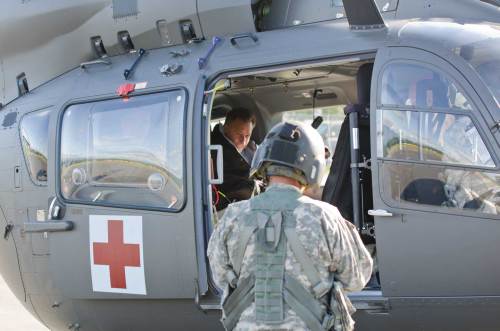

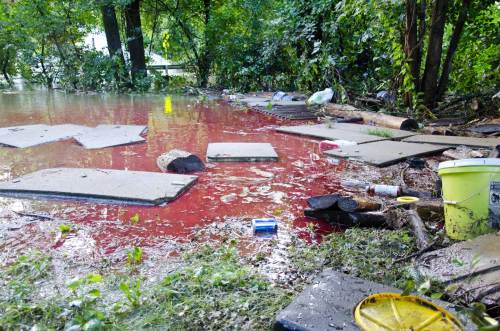

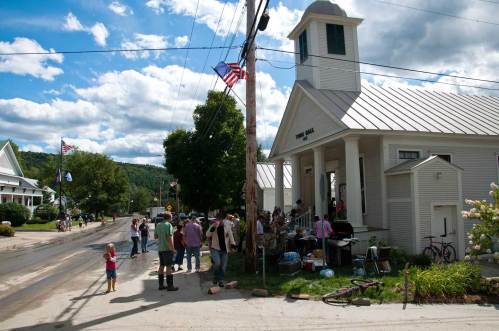
It is difficult not to use the language of hyperbole to describe the water damage that has affected every county of the state. Words like “unbelievable,” “epic,” “unprecedented” and “historic” are a few of the adjectives that Vermonters are using to describe the aftermath of Tropical Storm Irene.
Irene is the worst weather event to hit Vermont in 84 years (since the Flood of 1927). The storm left a trail of destruction that is difficult to comprehend. Though the heavy downpour of six to seven inches that fell on most of Vermont was consistent, the floodwaters that raged in one community or another appeared to be arbitrary.
When Sen. Patrick Leahy and Gov. Peter Shumlin toured the damage by helicopter on Monday, they found that towns just five or 10 miles apart were alternately among the stricken and the spared.
“I’ve not seen anything that has shocked me as much,” Leahy told reporters at the Knapp Airport in Berlin.
Shumlin described the extent of the wreckage left in the trail of the storm as “incomprehensible damage.”



The storm, he told reporters, made the Memorial Day weekend flash floods that devastated the central Vermont cities of Barre and Montpelier seem like a warm-up run.
The sense of outsized destruction in those places that were hit was universal. As one municipal official in Bennington County put it, the road and bridge damage gives new meaning to the old Vermont saw “you can’t get there from here.” Rescue operations and utility companies had to drive as much as 100 miles out of the way in some cases to bring relief to residents effectively trapped in 11 towns that the Agency of Transportation has declared are “cut off” from the state’s roadways.
In just 24 hours, Irene has transformed Vermont. It has taken the lives of three Vermonters (a fourth is missing). Several hundred roadways have been damaged; 33 bridges have been severely damaged. More than a dozen downtowns have been scoured by rushing water. Water and sewage treatment facilities have failed. Hundreds of buildings, many of them historic structures, have been compromised. Dozens of businesses, including restaurants, stores, hotels, offices and theaters have been destroyed. Public safety buildings in many towns have been damaged.
Utilities say it could be weeks before power is restored in some areas because of the havoc wreaked on state and local roads.
Irene also hit the “nerve center” of state government, as Shumlin described it. The State Office Complex, which houses 2,000 state employees and features an extensive underground tunnel system, was inundated with water on Sunday as a flash flood washed through Waterbury. Several feet of water laced with oil and sewage rushed into the buildings. Computer systems for two of the state’s largest agencies – human services and natural resources — were damaged (the hard drives have been salvaged and will be rebuilt).
Only a small percentage of state employees will be called back to alternative work spaces (including the old Redstone building in Montpelier). Everyone else has been asked to stay home for the next several weeks while the Shumlin administration figures out what to do with the old state mental hospital that for decades has served as the primary seat of the state’s bureaucracy. The 51 severely mentally ill patients who were housed in a building at the complex will be temporarily relocated to other institutional settings, including Second Spring, Fletcher Allen Medical Center, Southern State Correctional Facility and the Brattleboro Retreat.
As the state assesses the IT systems and the integrity of the buildings, Shumlin asked for “patience and cooperation from state employees and taxpayers.”
President Barack Obama signed a disaster declaration for Vermont on Monday morning, making the state eligible to receive federal highway and emergency rescue and debris removal aid. The governor hopes Obama will declare the state a major disaster area, which would enable residents and business owners to obtain assistance as well. In addition, Shumlin announced that the state will approve a $1.4 million investment that will leverage $10 million in loans for businesses through the Vermont Economic Development Authority.
Leahy and Shumlin rejected criticism from the national media that the state should have evacuated residents in advance of the storm. “What should we do, evacuate the whole state?” Shumlin remarked.”
Estimates for the total damage Irene has wreaked on private and public property won’t be available for some time, but Sen. Bernie Sanders declared that the cost would total tens of millions of dollars and scar the Green Mountain State for years to come.
Leahy and Shumlin rejected criticism from the national media that the state should have evacuated residents in advance of the storm. “What should we do, evacuate the whole state?” Shumlin remarked.
“They should get out of the big city sometime,” Leahy said. “Where do you evacuate to? It (the storm) was capricious.”
Shumlin said the state began preparing three days in advance of the storm to coordinate local and state emergency responders. “We did the best we could … given what we were dealt,” Shumlin said.
The rescue and restoration effort has been led by the Vermont National Guard, the Department of Public Safety, state highway and emergency personnel and municipal police and fire departments.
Adj. Gen. Michael Dubie said he was pleased with the interaction between local and state workers.
“We have mitigated some of the hardship, but we have a long way to go,” Dubie said. “One of the first things we heard was ‘thank you for sending the guard.’”
Mark Bosma, communications director for Vermont Emergency Management, said the state is asking people to stay off the roads, not only because state and town highways are in bad shape, but also because traffic can interfere with the rescue and restoration efforts of first responders and utility crews.
He said many Vermonters have been confused about the emergency call-in system. 5-1-1 is for road information; 2-1-1 is for United Way disaster relief.
Details of the damage
As the water receded, more personal tragedy and damage to whole communities came to light on Monday.
Three people have died – a Ludlow boater, a municipal official in Rutland and a 21-year-old woman in Wilmington – and one man remains missing.
The Rutland Herald has reported that Mike Garofano, Sr., was found dead in Rutland. Garofano was the city’s water treatment plant supervisor. His 25-year-old son, also named Mike, was missing after the two men checked the Mendon Brook inlet on Sunday afternoon.
Flooding in Wilmington disconnected the small village of about 100 souls and three dozen buildings from the state highway system. Most of the 19th century era structures in the village are severely damaged. Several buildings have disappeared – the concrete pad for one home is on Route 9 and the rest of the structure is in nearby Lake Whitingham. A dozen propane tanks are also bobbing in the lake. The village water and sewer systems have been compromised and about 40 people are temporarily housed in the high school.
The Wilmington Town Clerk’s office bore a mark on the outside wall of the building for the last big high water event in this Massachusetts border town – the Hurricane of 1938. Irene crested three inches above that level, according to Rep. Ann Manwaring, D-Wilmington. She helped the town clerk move the records to the second floor of the building the morning before the floodwaters dumped 4 feet of water on the first floor.
The municipal infrastructure – the police and fire station – is “shot,” Manwaring said. Dot’s Restaurant, a local landmark, may not survive, she said.
What the rushing waters of the Deerfield River have done to her town is “just pitiful,” as she put it.
The only way out of town is south through Massachusetts, Manwaring said. The roads to the east, west and north are impassable.
Wilmington is one of 11 communities cut off from the state’s transportation system, according to Chris Cole, a deputy director at the Vermont Agency of Transportation. The others include: Chester, Rochester, part of Stockbridge, Mendon, Killington, Cavendish, Ludlow, Middletown Springs, Granville and Stratton.
Transportation challenges
Brian Searles, secretary of the Agency of Transportation, said he has made restoring access to these towns the agency’s No. 1 priority.
Many of those municipalities are isolated in part because of the 33 state highway bridges that have been closed.
“They’re not all washed away,” Cole said. “It means they’re damaged to point that they’re not open to traffic. Some will be rehabilitated and can be re-opened, but they all need to be inspected.”
Bridge inspections are the next highest item on Searles’ list. The agency is seeking assistance from engineers in Massachusetts and New Hampshire, as well as the Federal Highway Administration.
U.S. Route 7 has seven closures: two in Manchester, and one each in Sunderland, Mt. Tabor, Rutland and Brandon.
Route 100 has six closures in Wilmington, Jamaica (which also has three bridges out on Rte. 30), Stamford, Rochester and Stockbridge.
Route 4 has closures in Mendon and Killington. On Route 103 bridges have been closed in Mt. Holly and Chester. On Route 12, Bethel and Barnard bridges are out. And on 12A the bridge to Braintree is closed.
